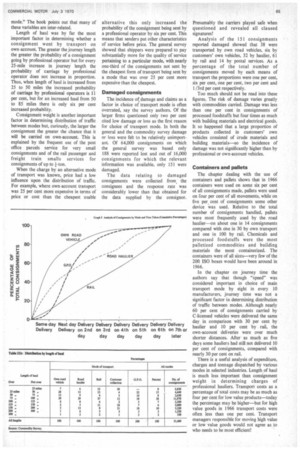Why industry chooses road or rail
Page 86

Page 87

If you've noticed an error in this article please click here to report it so we can fix it.
byJohn Darker, AIVIBIM THE recent publication by the Ministry of Transport, Industrial Demand for Transport (HMSO price £2), adds weight to the volume of useful statistical information about road transport. Designed as "a study of the determinants of demand for transport, of transport facilities and the characteristics of consignments in manufacturing industry", the inquiry was first planned in the autumn of 1965 and most of its data was collected in 1966 and 1967. Attitudes may have altered somewhat since then under the influence of operators' licensing and the greatly extended Freightliner system.
It is probably inevitable in so complex an industry as transport that sampling methods must be used to gather the data that is afterwards minutely analysed and dissected. Any attempt to gather data from all firms using transport and from the transport managers concerned, whether own-account, or professional haulage, would take far too long and cost the earth. And even were it attempted, a proportion of those concerned would refuse to collaborate.
Initial1y4 1015 establishments were sampled of which 722 (71 per cent) completed the Ministry's questionnaire in a manner suitable for analysis. The authors of the book (B. T. Bayliss and S. L. Edwards) were gratified that there was such an extremely high response rate for the voluntary completion of a questionnaire involving a great deal of work. Some of the manufacturers questioned completed the questionnaire but jibbed at completion of special consignment notes for a sample of consignments leaving their establishment.
In fact, two broad types of information were collected. The first type related to the transport arrangements of the establish ments and the traffic dispatched by them during one year distinguished by the mode used; the second type related to a sample of consignments dispatched during the survey period.
The first source of information provided data on such factors as the size and composition of traders' vehicle fleets; the frequency of Contract A and C-hiring arrangements; ownerships of rail sidings and canal berths; and annual traffic generated. The second source yielded information on the nature of consignments and the influence of factors such as consignment weight and type, containerization, origin and destination, and price upon the distribution of traffic between modes.
Three factors What does determine the choice of transport mode by a shipper or—as most hauliers would say—sender? The authors of the book say it is not the actual price of alternative modes which influences modal choice but what the shipper thinks is the actual price. Subjective factors enter into other assessments made by senders, for example length of journey time or the incidence of loss or damage by alternative modes.
Three broad factors, it appears, bear upon the choice of mode of senders. "First, the completely factual information relating to the consignment, eg its size, destination, use of container, ancillary service performed; secondly, the factual information relating to the firm itself, eg its size and location; and thirdly the subjective assessments of the shipper relating to freedom from loss and damage, speed, ready availability and charges by alternative mode." The book points out that many of these variables are inter-related.
Length of haul was by far the most important factor in determining whether a consignment went by transport on own-account. The greater the journey length the greater the probability of a consignment going by professional operator but for every 25-mile increase in journey length the probability of carriage by professional operator does not increase in proportion. Thus, when length of haul is increased from 25 to 50 miles the increased probability of carriage by professional operators is 11 per cent, but for an increased haul from 50 to 85 miles there is only six per cent increased probability.
Consignment weight is another important factor in determining distribution of traffic between modes but, curiously, the larger the consignment the greater the chance that it will be carried on own-account. This is explained by the frequent use of the post office parcels service for very small consignments and of the rail passenger and freight train smalls services for consignments of up to fton, When the charge by an alternative mode of transport was known, price had a low influence upon the distribution of traffic. For example, where own-account transport was 25 per cent more expensive in terms of price or cost than the cheapest usable alternative this only increased the probability of the consignment being sent by a professional operator by six per cent. This means that senders put other characteristics of service before price. The general survey showed that shippers were prepared to pay substantially more for the quality of service pertaining to a particular mode, with nearly one-third of the consignments not sent by the cheapest form of transport being sent by a mode that was over 25 per cent more expensive than the cheapest.
Damaged consignments The incidence of, damage and claims as a factor in choice of transport mode is often overrated, say the survey authors. Of the larger firms questioned only two per cent cited low damage or loss as the first reason for choice of transport mode. In both the general and the commodity survey damage or loss were felt to be relatively unimportant. Of 64,000 consignments on which the general survey was based only 188 were reported lost and out of 16,000 consignments for which the relevant information was available, only 151 were damaged.
The data relating to damaged consignments were collected from the consignees and the response rate was considerably lower than that obtained for the data supplied by the consignor. Presumably the carriers played safe when questioned and revealed all claused signatures!
Analysis of the 151 consignments reported damaged showed that 38 were transported by own road vehicles, six by customers' own vehicles, 32 by haulier, 61 by rail and 14 by postal services. As a percentage of the total number of consignments moved by each means of transport the proportions were one per cent, six per cent, one per cent, two per cent and 1/3rd per cent respectively.
Too much should not be read into these figures. The risk of damage varies greatly with commodities carried. Damage was less than one per cent in consignments of processed foodstuffs but four times as much with building materials and electrical goods. It so happened that a large proportion of products collected in customers' own vehicles consisted of crude materials and building materials—so the incidence of damage was not significantly higher than by professional or own-account vehicles.
Containers and pallets The chapter dealing with the use of containers and pallets shows that in 1966 containers were used on some six per cent of all consignments made, pallets were used on four per cent of all movements, while on five per cent of consignments some other device was used. Relative to the total number of consignments handled, pallets were most frequently used by the road haulier—on about one in 14 consignments compared with One in 30 by own transport and one in 100 by rail. Chemicals and processed foodstuffs were the most palletized commodities and building materials the most containerized. The containers were of all sizes—very few of the 20ft ISO boxes would have been around in 1966.
In the chapter on journey time the authors say that though "speed" was considered important in choice of main transport mode by eight in every 10 manufacturers, journey time was not a significant factor in determining distribution of traffic between modes. Although nearly 60 per cent of consignments carried by C-licensed vehicles were delivered the same day in comparison with 30 per cent by haulier and 10 per cent by rail, the own-account deliveries were over much shorter distances. After as much as five days some hauliers had still not delivered 10 per cent of consignments, compared with nearly 30 per cent on rail.
There is a useful analysis of expenditure, charges and tonnage dispatched by various modes in selected industries. Length of haul is much less important than consignment weight in determining charges of professional hauliers. Transport costs as a percentage of total costs may be as much as four per cent for low value products—today the percentage may be higher—but for high value goods in 1966 transport costs were often less than one per cent. Transport managers responsible for moving high value or low value goods would not agree as to who needs to be most efficient!




































































































































































